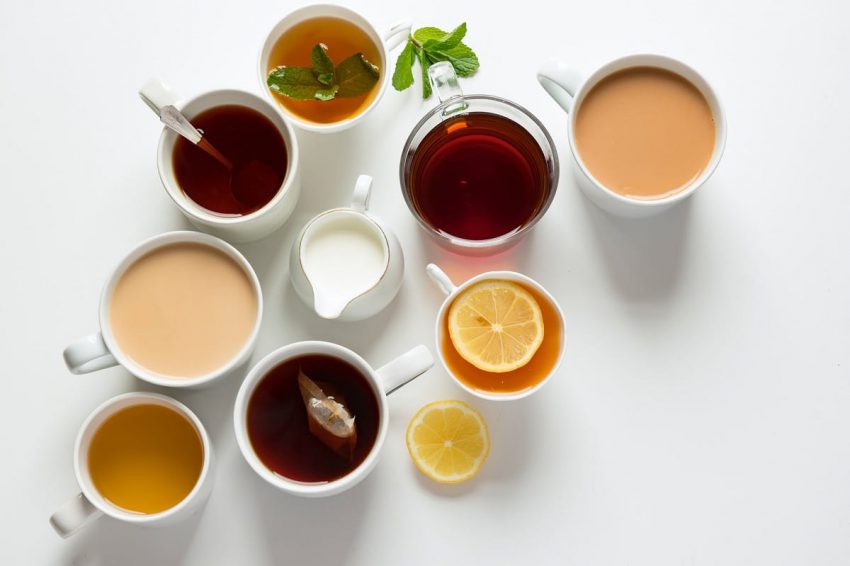Choosing The Right Tea Type According To Your Needs

Statistics show that right after water, tea is the second most popular drink in the world. Given that it has been around since 2700 BC, tea’s popularity shouldn’t come as such a surprise because it plays an important role in people’s everyday lives. In fact, the first time tea was recorded in history, more specifically in China, it was considered a medicinal beverage.
Although there may be over 1000 varieties of tea, not all are regarded as “true”. In fact, true teas are made from a tea leaf called Camellia sinensis plant which is present only in the basic tea types. The other tea-like beverages that don’t come from this plant aren’t regarded as teas, but as infusions instead.
With that being said, there are only five main types of teas. The biggest difference between these tea variations is mostly in the process of how they are made. In addition, each tea type has a unique flavor and various health benefits. So if this warm beverage plays a major part in your diet, here is a brief description of each tea type to help you make the right choice according to your needs.
Green tea
Green tea is regarded as one of the healthiest beverages in the world. It has a light, fresh and even slightly grassy flavor profile which separates it from the other tea types. As it is full of antioxidants, green tea has many health benefits like reducing the risks of cancer and other severe health conditions.

For example, drinking this tea will keep you alert as it contains caffeine which helps improve brain function and blocks inhibitory neurotransmitters. In addition to this, caffeine can help in the process of fat burning by making the burned fatty acids available for use as energy.
Herbal experts like Harney & Sons recommend the following types of green tea:
- Biluochun, as the most distinguished green tea Chinese beverage with a strong aroma and vegetal flavor
- Matcha tea, which is popular for its creamy, savory and bittersweet flavor
- Longjing or Dragon Well tea, known for being hand-roasted and having a fresh, slightly sweet and nutty flavor
Black tea
Black tea is the most popular type of tea in the West. What separates it from the other tea types is that it is fully oxidized and it doesn’t contain any calories, carbohydrates or fats. It has a strong, dark flavor and more caffeine than other teas, but less than coffee.
This tea type contains antioxidants and compounds that provide a variety of health benefits. For example, the flavonoids present in black tea help boost heart health and reduce risk factors for developing severe heart diseases. Also, because of the presence of caffeine and L-theanine, black tea improves focus and alertness by increasing alpha activity in the brain.

Most common types of black tea include:
- Earl Grey, known for its fresh, citrus flavor from the bergamot fruit
- Ceylon black tea, which has a bold flavor with hints of chocolate or spices
- English breakfast, with a strong and rich flavor with a few vegetal notes
White tea
White tea has the most delicate flavor out of all “true” teas because it comes from the new buds and leaves of the Camellia sinensis plant. As it consists of a high amount of antioxidants, white tea helps prevent many heart diseases, weight loss and even combat skin aging.
This tea type is full of catechins which act as antioxidants and protect the body cells from damage. These compounds help reduce the risk of many health diseases and boost the immune system. Also, white tea consists of fluoride which helps prevent dental cavities by making the teeth resistant to bacteria.

Most common types of white tea include:
- Silver Needle, the rarest white tea with a floral scent and sweet flavor
- White Peony, known for its slightly nutty aroma and strong flavor
- Long Life Eyebrow, which is famous for its golden yellow color and strong flavor
Oolong tea
Oolong tea is most commonly known as the black dragon tea and it is considered the traditional hot beverage of China. The oxidation levels of this tea type are responsible for its diverse color and flavor which ranges from sweet and fruity to smoky.
Because it doesn’t contain any calories, it is often used in many weight loss programs and low-calorie wellness diets. It is full of caffeine which helps boost mental and physical energy by speeding up the metabolism and burning more calories. Also, the presence of antioxidants in oolong tea can help treat acne and other skin blemishes.
Other health benefits include lowering risk factors of cancer and diabetes and decreasing inflammation.

The most common types of oolong tea include:
- White Tip, known for its fruity and crisp finish
- Red Robe, known for being more oxidized with a rich, earthy flavor
- Iron Goddess, famous for featuring fruity and sweet flavor notes
Pu-erh tea
Pu-erh tea is a fermented tea that is made from the leaves of the “wild old tree” grown in the Yunnan Province of China. What makes this tea stand out from the rest is that it is usually sold in compressed “cakes” of tea leaves.
Although research is still ongoing about its health benefits, pu-erh tea has shown positive effects in several ways. For example, it is high in antioxidant properties and its caffeine content supports mental alertness. Also, since it is fermented, it produces healthy probiotics which help improve blood sugar controls and manage weight. The tea extracts help reduce cholesterol levels and excess fat accumulation.
The flavor of the pu-erh tea is defined by how long the pu-erh has aged. Because of this, there are three common types:
- Young raw pu-erh with a fresh and grassy flavor
- Aged raw pu-erh with an earthy and sometimes a bit fruity taste
- Ripe pu-erh with a creamy and earthy flavor

Final thoughts
With so many tea varieties out there, it can be difficult to settle on just one. Whether you are new to tea or have been sipping it for years, choosing the right tea type for you mostly relies on your senses. However, although all tea types may share similar properties, there are certain health benefits that separate each type from the rest. So, when you are choosing your tea type, keep this brief guide in mind in order to help you make the right decision and pick the one that best fits your needs.



